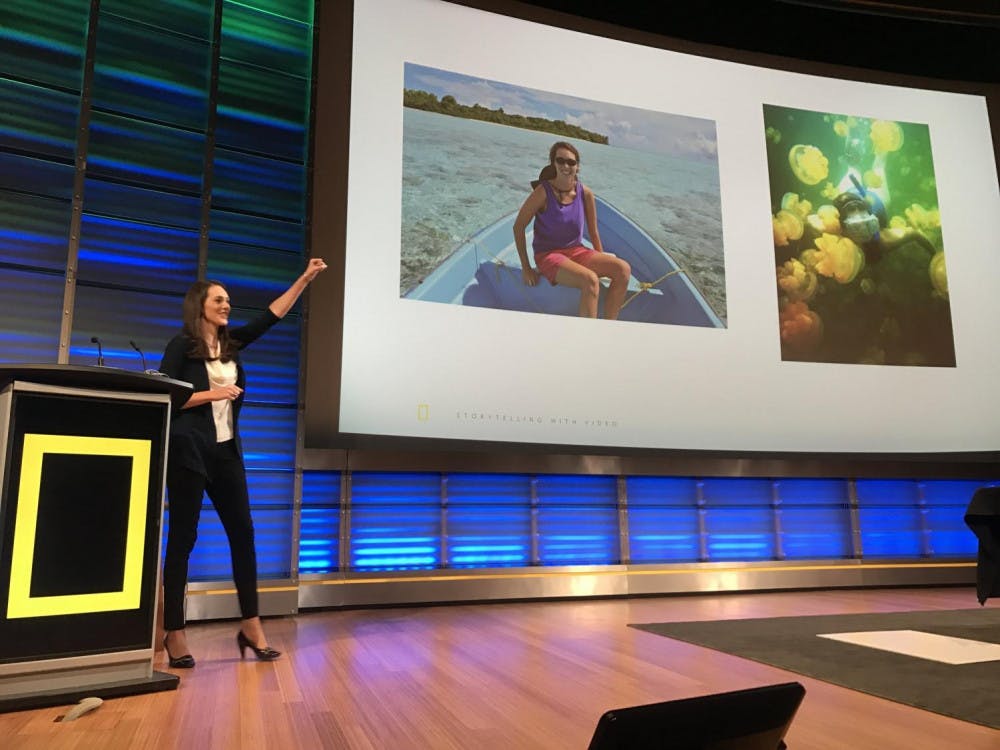Carolyn Barnwell ’07 came to speak on Thursday, March 15 in the Franklin Environmental Center at Hillcrest. Her presentation, “Visual Storytelling for Science and Conservation Impacts,” was part of the Environmental Studies Colloquium and focused on how scientists and conservationists can translate their data into stories to capture the attention of broad audiences.
Having found her love for storytelling in Ethnographic Methods, a course within the Sociology-Anthropology department in Middlebury, Barnwell used her college study-abroad experience to help farmers in Thailand break into the American fair-trade market by journaling and videotaping them and handing out video copies of her encounters to organizations in the US. Following her success in this field, Barnwell graduated in 2007 with a B.A in Human Ecology from the Environmental Studies department. Upon graduation, she continued to pursue her passion for environmental advocacy through the Thomas J. Watson Fellowship on climate change impacts and responses in the Pacific and Indian Oceans. In 2011, she joined National Geographic as an Associate Producer for the Science and Exploration Media Team and has dedicated her life to helping scientists tell their stories about global and local issues in creative and empathic ways.
Barnwell structured her presentation around the notion that scientists and conservationists often focus their work on statistics and figures that are incomprehensible to the general audience, creating a lack of attention and empathy on environmental topics that affect the greater public. Barnwell believes that in order to create successful communication, scientific stories need to have “empathy, engagement and focus.” She adores the quote, “Communicating science is as important as practicing it” because it captures her belief in the connection between science and storytelling.
Convinced that storytelling is an engrained human ability that allows us to pass on narratives from one generation to the next, Barnwell captured the audience by mentioning that telling stories excite the same hormone, oxytocin, in an individual as falling in love.
However, in order to do so, one needs to be effective in reciting the story and mentioning dry facts will not cut it. To test this out, Barnwell tried two exercises with the audience. First, she mentioned facts about the world’s melting glaciers, followed by another story of her personal experience in Iceland with vivid descriptions of the magnificent mountains and the sea that enchanted her. As her story had no jargon about the polar ice caps and tapped into the human ability to empathize, she believed it was more impactful.
Empathy, to Barnwell, is the ability to meet the emotions of another. Creating stories that empathize often triggers action from audiences. If explored through the lens of a single person, stories tend to be more effective than when generalizing about group events.
In addition to empathy, Barnwell discussed how important it is to focus on concepts for a broad audience. In fact, she said that National Geographic uses a strategy of ensuring that all their scripts are understandable to 12-year olds.
In a world with shorter attention spans, videos and stories need to be concise and precise, as the idea is to capture the audience’s attention and inspire them to search for more knowledge after having watched the video. She presented two videos, the first about the efforts to protect the natural landscape of Gabon and the other on the preservation of the Arctic seas. The former was captured by fellow National Geographic conservationist Mike Fay, whose work created a comprehensive database that they shared with Gabon’s president, leading to the creation of 13 national parks in Gabon and U.S. funding to protect the Congo Basin.
“Through visual storytelling, one can provoke action,” Barnwell said. “Science based conservation cannot have an impact without storytelling. Empathy and focus need to be used to bridge science to a story.” Barnwell believes that one of the most effective ways to do so will be through virtual realities, a system that various conservation groups have been trying to promote for future efforts.
The Power of Empathy in Science

Comments



